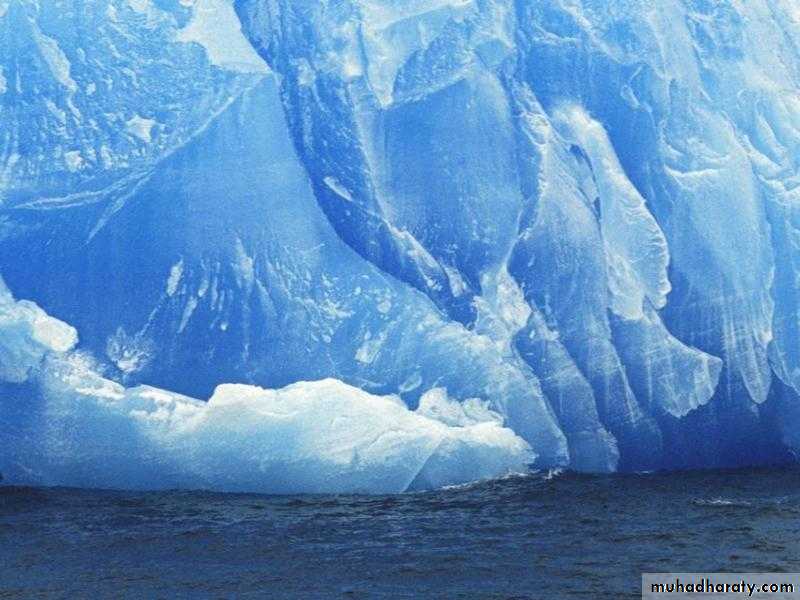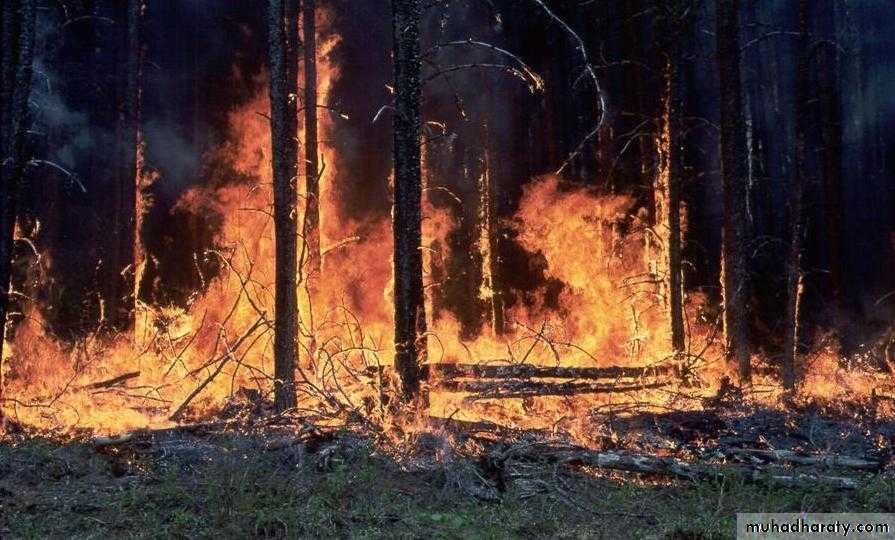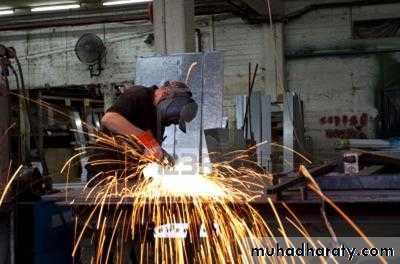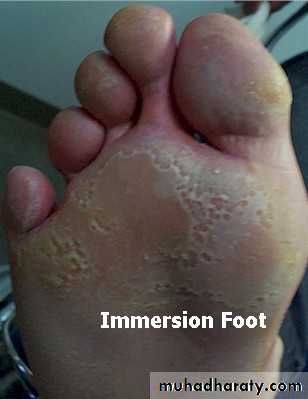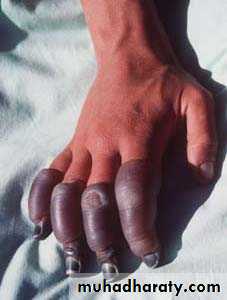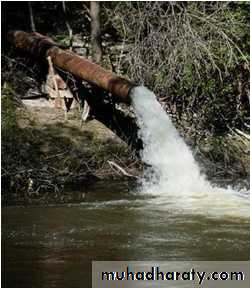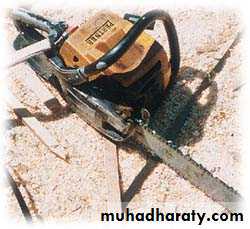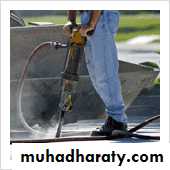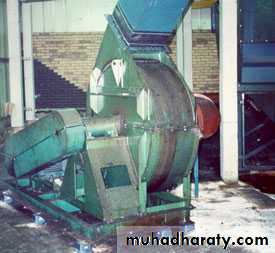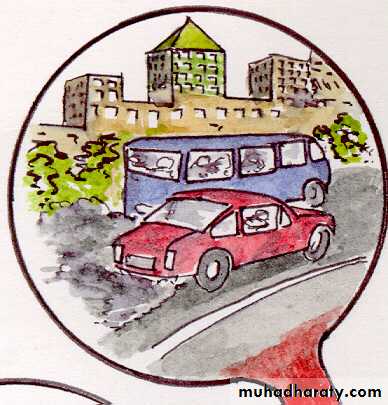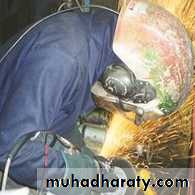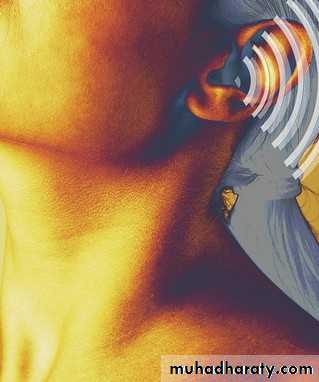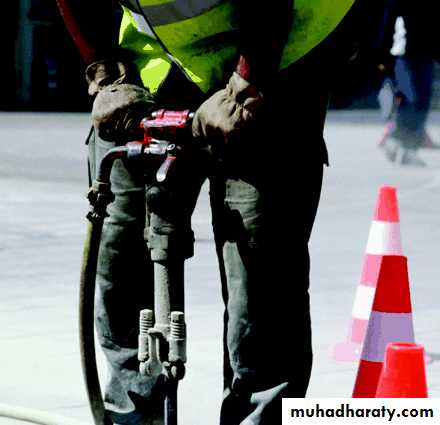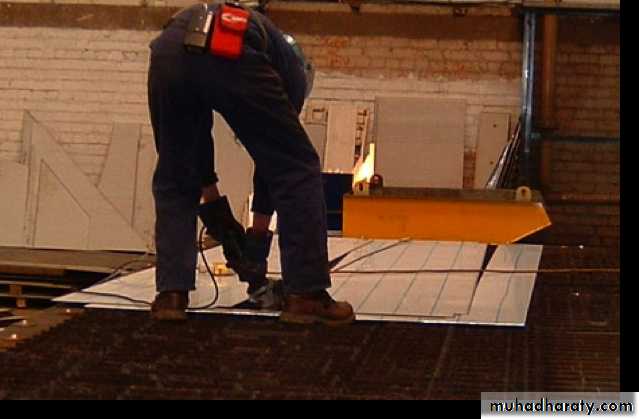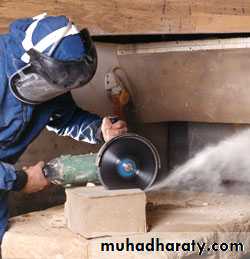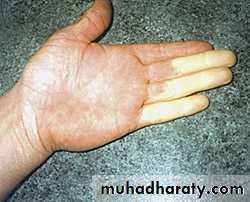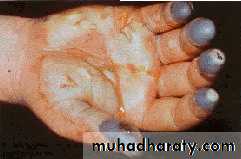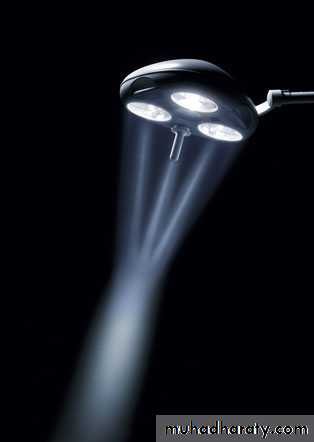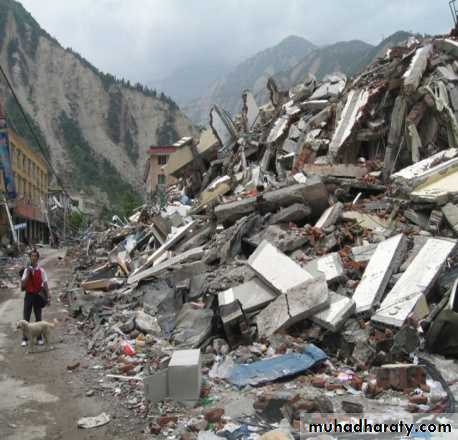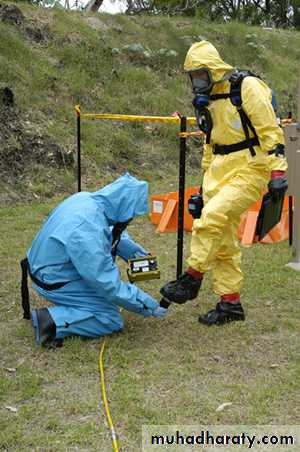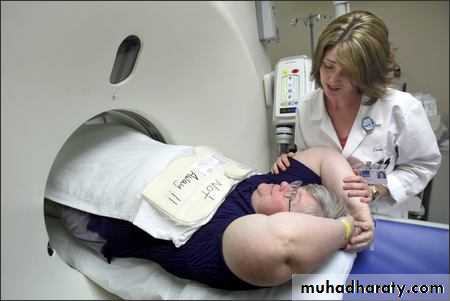Occupational MedicinePhysical Hazards
ByDr. Aliaa Makki
Community Medicine Dept.
By the end of this lecture you will be able to:
• Correlate physical occupational hazards to health problems• Explain the impact of exposure to heat, cold, noise, vibration, abnormal air pressure and defective illumination on health
Objectives
A hazard is something that can cause harm if not controlledWhen the hazard is present there is a possibility of an accident.
Physical hazards include:
• Falls from height,
• Dangerous machinery,
• Pressure vessels
• Electricity
Physical
Hazardous AgentsHeat
Caloric dis.
Cold
Frigoric dis.
Changes in atmospheric pressure
Decompression illness, Diver's paralysis
Noise
Occupational deafness
Light
Photoactinic disease
Vibration
Vibration disease
Radiation
Cancer, leukemia, genetic effect
BOSH Training 2009 OSHC
EXTREME
TEMPERATURE
Occupational exposure to heat
Factors influencing interchange of heat between man his environment;Air temp.
Air velocity
Moisture content of the air
Heat problems results when these factors interact to produce a working environment that may be uncomfortable or even hazardous
The mechanisms of heat loss:
Radiation of heat from the body to the air (air is cooler than body).
Evaporation of sweat (cool the body).
Insensible loss through respiration.
The physiological effect of heat
Depend on:Cooling power of the air,
The heat regulating mechanism of the body
Environmental condition
Amount of physical activity
Alcohol consumption
Certain disease conditions (fevers & diarrhea).
The harmful effect of
heat:Rise in body temperature
Loss of fluid
Depletion of salts
Excessive vasodilatation
Drop in blood pressure in certain conditions.
Occupational exposure to heat
Occur in:
Foundries
Bakeries
Laundries
Engine rooms
Iron, steel, other metals industries
Manufacture of textiles, glue,
glass & ceramic.
Heat may be a hazards in exposure to direct sunlight in tropical climate &deserts.
Occupational exposure to heat;Caloric disease (heat over exposure):
Heat exhaustion or collapseSigns & symptoms;
Fatigue
Headache
Dizziness
Inability to concentrate & work
Profuse sweating
Cool moist skin
Low blood pressure
Collapse
Occupational exposure to heat
Heat cramps
Prolong exposure to high environmental & occupational temperature with heavy muscular work
Signs & Symptoms;
Profuse sweating,
Loss of body fluids & salts,
Painful spasmodic muscles cramps,
Abdominal colic,
Nausea & vomiting,
Albuminuria (transient),
Mental confusion
Heat stroke
Is the most serious effect of heat; common in tropics & high heat occupation, results from failure of heat regulating mechanisms(central).
Signs & Symptoms
Severe headache,
Dizziness,
Nausea,
Hyperpyrexia, hot & dry skin (cessation of sweating),
Normal or high blood pressure,
Coma & death may follow (fatality rate 40% or more).
Should be differentiated from other causes of coma
Occupational exposure to heat
Heat cataract
(Glass-blower's cataract)
Exposure to infrared rays from fire or glowing objects in ovens & glass industries.
Psychological effects
From prolong exposure to excessive heat; It causes
Irritability,
Anxiety,
Decrease moral & ability to concentrate,
Decrease working efficiency
Increase susceptibility to accidents.
Occupational exposure to cold
Tolerance of cold by the body is greater than tolerance to heatOccupational exposures include
Canned or frozen-food workers,
Dry-ice makers,
Ice cream makers,
Refrigerator repairmen,
Guards in cold climates
The effect of cold depends upon;
• Degree of coldness.
• Age, health, physical activity, & the amount of subcutaneous fat.
• Ability to acclimatize.
• Clothing.
• Duration of exposure.
Frigoric diseases(cold over exposure)
• Generalized chilling
If sudden & prolong; lead to
Dizziness,
Shivering,
Loss of memory,
Drop of B.P.& pulse,
Anesthetic coma.
• Trench or immersion foot
Among inactive solder due to long period in cold & humid climates
Local prolong chilling of feet
leading to vasospasm in the vessels
of feet & may
result in
gangrene
Frostbite
Results from sudden exposure to very low temp.Freezing point of skin 0-2°C, which become gangrenous & slough off.
Reddening of skin, localized burning pain and numbness.
Fingers, toes, cheeks, nose, ears are most susceptible.
Frigoric diseases(cold over exposure)
Acute transient inflammatory reactionStart in the skin with vasoconstriction,
Followed by vasodilatation &redness which may be due to liberation of a histamine-like substance.
Aggravation of vascular abnormalities
Include:
Raynaud's disease,
Acrocyanosis &
Thromboangitis obliterans.
Acute tracheitis
BOSH Training 2009 OSHC
NOISEOccupational exposures include:
Aircraft motor manufactory,Reboiler making,
Steel industry,
Textile industry,
Machine manufacturing,
Drilling & hammering of metals.
Noise; Unwanted sound
Noise; Unwanted sound
Include:Annoyance,
Decrease working efficiency,
Increase likelihood of industrial accidents,
Occupational deafness.
Harmful effect of sound
The 1st effect of acoustic stimulation is auditory fatigue (transient),
Continuous exposure (especially in susceptible individual) leads to permanent auditory change, first for low sound then to more disabling deafness.
BOSH Training 2009 OSHC
• Other Harmful Effects of Noise• Hypertension
• Hyperacidity
• Palpitations
• Disturbs relaxation and sleep
The noise levels for everyday sounds:
-Threshold for pain 140db-Wood working shop 110db
-Subway train at 20 feet 100 db
-Train whistle at 500 feet &inside motor bus 90db
-Heavy traffic at 25-50 feet 80 db
-Average traffic 70 db
-Conversational speech at 3 feet 60db
-Light traffic at 100 feet 50db
-Most sensitive hearing threshold 0db.
Hearing conservation:
Reduction of noise at source by inclosing noisy area with sound insulting partitions or silencing exhaust system.Limiting exposure in 8 hours a day & not > 90 dB.
Ear protection: ear plugs or earmuff
Routing monitoring
Includes pressure either above or below normal sea level pressure of 17.4 pound /inch² (1 atmosphere).
Occupational exposure to more than 1 atmosphere of compressed air occurs in:
deep sea divers (for pearls, sponge- fishing) ,
workers in pressurized caissons for building bridges or tunnels,
submarine personnel &underwater photographers &explorers using a self- contained underwater breathing apparatus.
Potential exposure to pressure below one atmosphere occur in pilots &crews of high performance aircraft.
Abnormal air pressure
Decompression illness=nitrogen disease:
under high pressure, large amount of gas dissolve in the blood & in body tissues, oxygen consumed & nitrogen remains. When pressure is reduced (during ascent or decompression), nitrogen is given up by tissues to the blood, which is responsible for most of the symptoms.
"Caisson disease" symp.: severe pains in &around the joints, esp. knees (the patient bends his knees to relive the pain).
Abnormal air pressure
Gas bubbles may affect the circulation in CNS leading to unconsciousness, cranial nerve affection, hemiplegia, paraplegia (diver's paralysis),
Bone lesions, aphasia, & Meniere's syndrome.
If decompression is rapid, pain in the ears & perforation of the drum may occur.
Chest pain, air embolism, & pneumothorax may lead to shock.
Distention of the intestine may occur.
If diving is to deep underwater, the narcotic effect of nitrogen appear.
Prevention: decompression symptoms do not occur if decompression is gradual (adequate recompression)
Abnormal air pressure
BOSH Training 2009 OSHC
VIBRATIONBOSH Training 2009 OSHC
Physical factor which affects man by transmission of mechanical energy from oscillating sourcesTypes
Segmental vibrationWhole body vibration
VIBRATION
Occupational exposures occur in:Drilling, breaking of concrete & asphalt roads, hammering of metals, shaping of metals &stones, mining etc.
Effect of vibration;
* high pitch vibration,& poorly designed or operated tools.
Females >males.
Damage &injury will occur, esp. to the elbow, from repeated pressing of bony surfaces.
Tendons, ligaments, nerves, & vessels are also affected, with pain, &disability,
Pallor,& even Raynaud's phenomenon.
Arthritic changes (later on).
Vibration
BOSH Training 2009 OSHC
• Health Effects:
• Hand Arm Vibration Syndrome (HAVS)
• tingling, numbness, blanching of fingers
• pain
Segmental Vibration:
BOSH Training 2009 OSHCHealth effects:
Fatigue
Irritability
Headache
Disorders of the spine
Whole Body Vibration:
BOSH Training 2009 OSHCINADEQUATE
ILLUMINATION
Defective illumination
Specific & general effects; may be seen in workers subjected to defective illumination & a large share of industrial accidents may be traced to it.Defective illumination;
too bright
too dim,
by reflection from shiny
surfaces, or throwing shadows which may hinder work or cause accidents
General effect of defective illumination include:
Feeling of general discomfort,
Muscular tension,
Eye fatigue, increased blinking of the eyes , decrease in visual acuity, aggravation of eye defects
Dizziness headache,
Blindness.
The workers show a decrease in their efficiency & work output, increase in work's errors.
Defective illumination
Low illumination:
1st symptom are loss of visual acuity, especially at night and photophobia.
In acute cases headache, eye oscillations & shock may develop.
Miners' nystagmus (rhythmic involuntary movement of the eyes) ,
(This may be seen in a latent or sub acute form)
Intense illumination:
Feeling of discomfort &eye fatigue
A brilliant light source like sun, a carbon arc, or a welder's arc may result in temporary or permanent blind areas in the retina (without proper protection).
Snow blindness characterized by burning, scratching of external surface of the eye as a result of exposure to the UV portion of the spectrum, which are absorbed in these tissues.
BOSH Training 2009 OSHC
RADIATIONBOSH Training 2009 OSHC
RADIATION• Types
• Sources
• Health Effects
• Ionizing
• X-rays
• Gamma rays
• Cancer,
• congenital defects,
• death
• Non-ionizing
• Ultraviolet
• Infrared
• Laser
• skin redness,
• premature skin ageing, &
• skin cancer
• corneal and conjunctival burns, retinal injury, cataract
• Skin and eye problem
Radiation protection:*Wearing a film badge which regularly changed once a month *Regular blood examinations (Hb level, PCV, white cell differential count ,*Wearing a leaded shield

